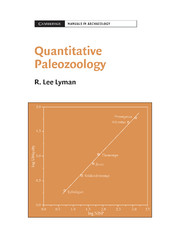Book contents
- Frontmatter
- Contents
- List of figures
- List of tables
- Preface
- 1 Tallying and Counting: Fundamentals
- 2 Estimating Taxonomic Abundances: NISP and MNI
- 3 Estimating Taxonomic Abundances: Other Methods
- 4 Sampling, Recovery, and Sample Size
- 5 Measuring the Taxonomic Structure and Composition (“Diversity”) of Faunas
- 6 Skeletal Completeness, Frequencies of Skeletal Parts, and Fragmentation
- 7 Tallying for Taphonomy: Weathering, Burning, Corrosion, and Butchering
- 8 Final Thoughts
- Glossary
- References
- Index
8 - Final Thoughts
Published online by Cambridge University Press: 05 June 2012
- Frontmatter
- Contents
- List of figures
- List of tables
- Preface
- 1 Tallying and Counting: Fundamentals
- 2 Estimating Taxonomic Abundances: NISP and MNI
- 3 Estimating Taxonomic Abundances: Other Methods
- 4 Sampling, Recovery, and Sample Size
- 5 Measuring the Taxonomic Structure and Composition (“Diversity”) of Faunas
- 6 Skeletal Completeness, Frequencies of Skeletal Parts, and Fragmentation
- 7 Tallying for Taphonomy: Weathering, Burning, Corrosion, and Butchering
- 8 Final Thoughts
- Glossary
- References
- Index
Summary
In this volume, some of the most basic issues of quantifying different kinds of paleozoological data have been explored. A bit more than two decades ago, Grayson (1984) published a book-length treatment on the same general topic, and that seemed to resolve many of the debates over how to quantify taxonomic abundances. Arguments over whether NISP or MNI was the better measure nearly ceased to appear in the literature. Yet, some individuals continue to report MNI values, either as the unit of choice for quantifying taxonomic abundances (e.g., Avery 1991, 1992; Landon 1996), or apparently for the sake of complete descriptive reporting (e.g., Plug 2004; Stahl and Athens 2001). A few continue to develop innovative ways of tallying MNI (e.g., Vasileiadou et al. 2007). The usual reason given for use of MNI is that NISP is subject to intertaxonomic variation in fragmentation and so gives potentially biased estimates of taxonomic abundances. Although it is true that NISP can influence estimates of taxonomic abundance, those who use the differential fragmentation argument as a warrant to determine MNI values neither empirically evaluate the truthfulness of this warrant in their particular instances nor fail to present NISP data. Why do they present what they take to be biased data? Why do they not determine if in fact fragmentation varies intertaxonomically rather than simply assert that it does? Perhaps they do not because of a lack of mathematical and statistical sophistication. That lack of sophistication is a major reason for this book.
- Type
- Chapter
- Information
- Quantitative Paleozoology , pp. 299 - 308Publisher: Cambridge University PressPrint publication year: 2008

